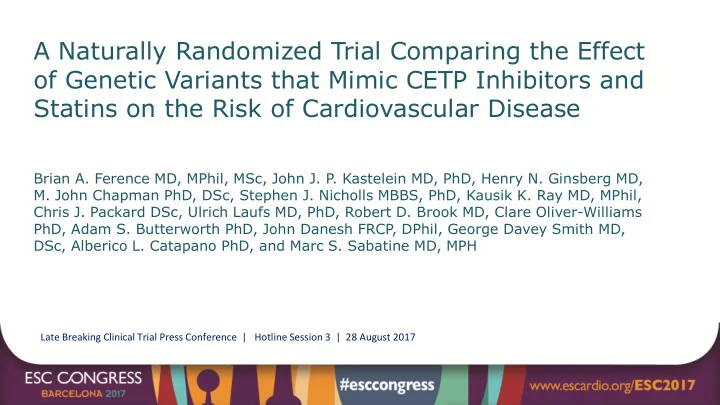

A Naturally Randomized Trial Comparing the Effect of Genetic Variants that Mimic CETP Inhibitors and Statins on the Risk of Cardiovascular Disease Brian A. Ference MD, MPhil, MSc, John J. P. Kastelein MD, PhD, Henry N. Ginsberg MD, M. John Chapman PhD, DSc, Stephen J. Nicholls MBBS, PhD, Kausik K. Ray MD, MPhil, Chris J. Packard DSc, Ulrich Laufs MD, PhD, Robert D. Brook MD, Clare Oliver-Williams PhD, Adam S. Butterworth PhD, John Danesh FRCP, DPhil, George Davey Smith MD, DSc, Alberico L. Catapano PhD, and Marc S. Sabatine MD, MPH Late Breaking Clinical Trial Press Conference | Hotline Session 3 | 28 August 2017
Background • Mendelian randomization studies consistently demonstrate that LDL cholesterol (LDL-C) appears to be causally associated with the risk of cardiovascular disease • Numerous randomized trials have demonstrated that reducing LDL-C reduces the risk of CVD by 20% per mmol/L, independent of how LDL-C is lowered • Notable exception are CETP inhibitors: in ACCELERATE trial evacetrapib reduced LDL-C by 0.75 mmol/L but did not reduce cardiovascular events • Challenges the causal effect of LDL-C on cardiovascular disease • Raises possibility that clinical benefit of lowering LDL-C depends on how it is lowered
Objectives • Evaluate the causal effect of lower LDL-C (and other lipoprotein measures) on the risk of cardiovascular events due to genetic variants that mimic the effect of CETP inhibitors • Compare with effect of lower LDL-C due to genetic variants that mimic the effect of statins (HMG-CoA reductase inhibition), ezetimibe (NPC1L1 inhibition), and PCSK9 inhibitors • To make inferences about whether the clinical benefit of lowering LDL-C depends on how LDL-C is lowered
Study Design & Population • Study Design: naturally randomized trial comparing effect of naturally random allocation to genetic variants that mimic the effect of CETP inhibitors, statins or both • Study Population: 358 205 participants from 77 studies (76 061 cardiovascular events) • Primary analysis: 102 837 participants from 14 prospective cohort or case-control studies • External Validation analyses: 189 539 participants from 48 studies • Primary outcome: major vascular events (MVE) defined as the first occurrence of non-fatal MI, stroke, coronary revascularization or coronary death
Results: CETP inhibition alone • Analogous to CETP inhibitor monotherapy • Concordant reductions in LDL-C and apoB and a lower risk of cardiovascular events that is proportional to the absolute change in LDL-C (same effect on MVE per unit lower LDL-C as variants that mimic statins, ezetimibe, PCSK9 inhibitors)
Results: Combined CETP and HMG-CoA reductase inhibition • Analogous to combined CETP inhibitor and statins (all RCTs have evaluated CETP inhibitors on background of statin therapy) • Discordant changes in LDL-C and apoB (due to an attenuated change in apoB) and a lower risk of cardiovascular events that is proportional to the absolute change in apoB, but less than expected per unit lower LDL-C
Conclusions • The causal effect of LDL on cardiovascular disease is determined by the circulating concentration of LDL particles (as estimated by apoB) rather than by the mass of cholesterol carried by those particles (as estimated by LDL-C) • Therefore, the clinical benefit of lowering LDL-C may depend on the corresponding reduction in LDL particles as measured by apoB • Clinical benefit of lowering LDL-C depends on how LDL-C is lowered • Therapies that reduce LDL-C by reducing LDL particles (e.g. statins, ezetimibe, PCSK9 inhibitors) should reduce the risk of cardiovascular events proportional to absolute change in LDL-C (or apoB) • Therapies that reduce LDL-C without proportionally reducing LDL particles (e.g. combined treatment with CETP inhibitors and statins) should reduce the risk of cardiovascular events proportional to the absolute change in apoB, which may be less than the expected for the observed change in LDL-C
Recommend
More recommend